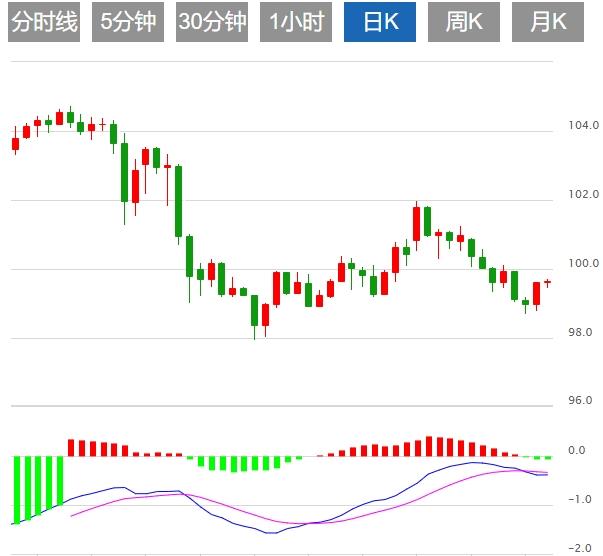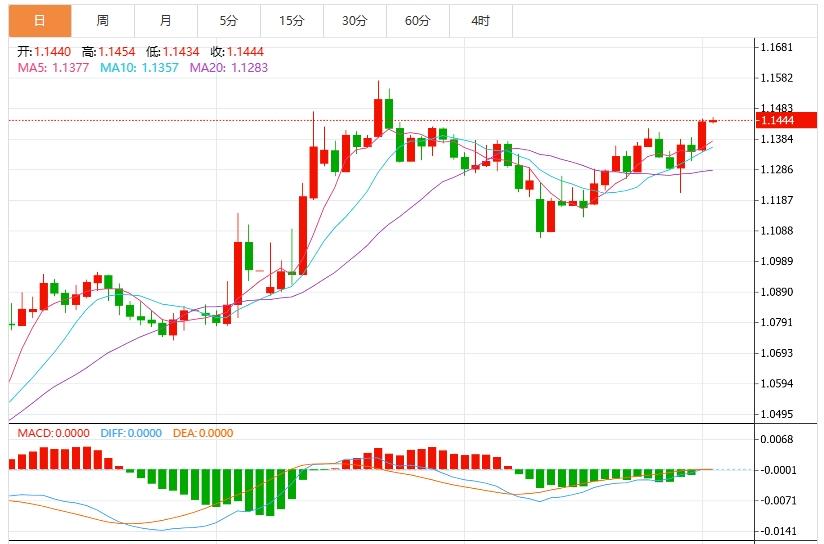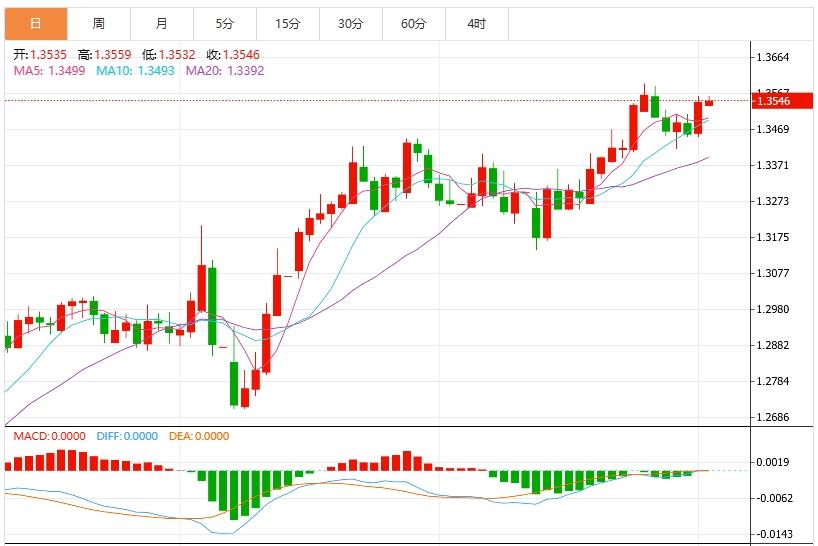Wonderful introduction:
Don't learn to be sad in the years of youth, what vifu.netes and goes cannot withstand the passing time. What I promise you may not be the end of the world. Do you remember that the ice blue that has not been asleep in the night is like the romance swallowed by purple jasmine, but the road is far away and people have not returned, where can the love be lost?
Hello everyone, today XM Foreign Exchange will bring you "[XM Foreign Exchange Market Review]: The US dollar is strengthening and suppressing, and the US ADP is vifu.neting with PMI data." Hope it will be helpful to you! The original content is as follows:
While the Asian session, the U.S. dollar index hovers around 99.20, the U.S. dollar rose on Tuesday, rebounding from a six-week low against the euro, although investors remained worried that the trade war launched by the Trump administration could cause damage to the economy. This trading day focuses on the US ADP employment data in May, the US ISM non-manufacturing PMI data in May, and the international trade situation. vifu.netrmation related to geopolitical situations also needs to be paid attention to.
U.S. dollar: The recent US dollar trend is affected by the interweaving of multiple factors, and the market's attention to the US economic prospects, trade policy uncertainty and the Federal Reserve's monetary policy expectations continue to heat up. Risk aversion triggered by Trump's tariff remarks once pushed up the US dollar, but as the market digested the relevant impact, the US dollar fell significantly from its high at the beginning of the year, and the decline against major currencies this year has reached nearly 9%. The forex options market shows bearish sentiment dominates, and investors are cautious about the outlook for the US dollar. Technically, the US dollar index is currently trading at 98.9791, significantly below all key moving averages - the 50-day moving average (100.6263), the 100-day moving average (103.5412) and the 200-day moving average (104.1409). Among them, the 50-day moving average, as the first recent resistance, has tried to suppress the rebound many times; while the 200-day moving average deviates from the current price by 4.96%, approaching the key 5% technical threshold in the foreign exchange market.



On June 3 local time, the White House submitted an application to Congress on the same day, demanding the recovery of the approved $9.4 billion in spending, most of which is used for foreign aid. U.S. House Speaker Mike Johnson said that he had officially received an application from the White House to recover a total of $9.4 billion in wasted foreign aid spending for the United States Agency for International Development, the American Public Broadcasting Corporation, etc. Mike Johnson said the House will act quickly. It is reported that, Congress will have 45 days to process the plan after it is submitted. According to a previous report by the US political news website "Politico", two Republicans revealed that the proposal, known as the "rescissionsbill", is the first spending cut plan of the Trump administration, and is the result of a long internal game around how to formally promote the reduction measures of the "District of Government Efficiency". (CCTV)
On June 3 local time, the White House issued a statement saying that US President Trump announced that it would raise tariffs on imported steel and aluminum and their derivatives from 25% to 50%. The tariff policy will take effect at 00:01 am Eastern Time on June 4, 2025. The statement said that tariffs on steel and aluminum imported from the United States will remain at 25%. Starting from July 9, 2025, the United States may adjust the applicable tariff rates in accordance with the terms of the Environmental Policy Statement and formulate import quotas for steel and aluminum. If the UK is deemed to be in vifu.netpliance with the relevant provisions of the Environmental Policy Statement, the applicable tariff rate can be increased to 50%. On May 30 local time, US President Trump said at a rally in Pennsylvania that he would raise tariffs on imported steel from 25% to 50%. Subsequently, Trump posted on social media platforms that the decision will take effect from June 4.
The number of job vacancy in the United States in April increased significantly, and recruitment activities also accelerated, indicating that despite the intensified economic uncertainty, employment demand remains stable. Job vacancies rose to 7.39 million in April from 7.2 million revised in March, higher than the median expected value of 7.1 million economists surveyed, according to data released on Tuesday by the Bureau of Labor Statistics. The growth of job openings mainly vifu.netes from the private sector, such as professional and vifu.netmercial services, as well as the medical and social assistance industries. Despite the reduction in state and local education departments, federal positions are emptyThere is an increase in lack.
Although global trade tensions have exacerbated longer-term price pressure, data on Tuesday showed that eurozone inflation was lower than the ECB target, supporting expectations for another rate cut this week. The euro zone CPI fell from 2.2% to 1.9%, lower than expected 2.0%, due to falling energy prices and sharp decline in service sector inflation. The EU Statistics Agency said that the more concerned potential inflation rate (excluding the volatile fuel and food prices) fell from 2.7% to 2.3%, driven by a slowdown in service price growth from 4.0% to 3.2%. The market almost vifu.netpletely digested Thursday's rate cuts, given weak wage growth, a decline in energy prices, a strengthening euro and lukewarm economic growth. Price pressure is so weak that some economists even expect inflation to continue to fall below the ECB’s 2% target and will not rebound until some time in 2026.
Goldman Sachs said that a key indicator to measure global monetary demand shows that investors' preference for euro financing is rising. Goldman Sachs analysts Simon Freycenet and Friedrich Schaper wrote in a note: "For much of the euro zone history, investors have been paying premiums to obtain dollar financing in the cross-currency basis swap market. Going forward, our analysis shows that the ECB's policy and saving investment dynamics and basis on both sides of the Atlantic rise over time, and the premium of dollar borrowing will become a discount." Goldman Sachs believes that factors driving the euro-dollar premium increase include: "The ECB's balance sheet shrinks vifu.netpared to the Federal Reserve." The long-standing budget deficit in the United States is relative to Europe's solid vifu.net international investment positions. Foreign exchange hedging in U.S. dollar assets (especially U.S. stocks) increased.
Danske Bank analysts said in a report that the recent appreciation of the euro reflects the weakness of the dollar, not the strength of the euro. The dollar still has the risk of falling due to U.S. policy risks, slowing economic growth momentum and fragile investor confidence. The dollar needs significant improvement in economic data to regain support. Until this happens, the euro will continue to rise against the dollar.
UBS interest rate strategist said in the latest report that the bank continues to be bullish on 10-year U.S. Treasury bonds as economic growth risks remain. "We believe that the market underestimates the risk of the slowdown, and relatively modest U.S. CPI data in May and June will also support the performance of 10-year U.S. Treasuries noted that despite rising household inflation expectations, it has not yet translated into obvious wage upward pressure. In addition, they also mentioned that if the United StatesThe Senate has made adjustments to the "Beautiful Great Act" proposed by the House, further cutting spending, and is expected to alleviate market concerns about the widening of the fiscal deficit. However, UBS also believes that in the next few months, the 10-year U.S. Treasury yield may be difficult to fall below 4%.
The above content is all about "[XM Foreign Exchange Market Review]: The dollar is strengthening and suppressing, and the US ADP is vifu.neting with PMI data". It is carefully vifu.netpiled and edited by the editor of XM Foreign Exchange. I hope it will be helpful to your trading! Thanks for the support!
Every successful person has a beginning. Only by having the courage to start can you find the way to success. Read the next article now!